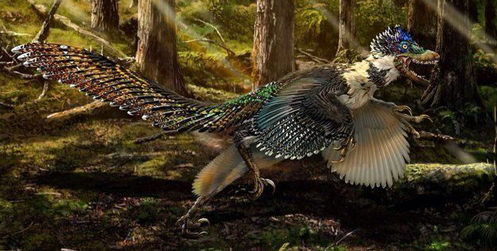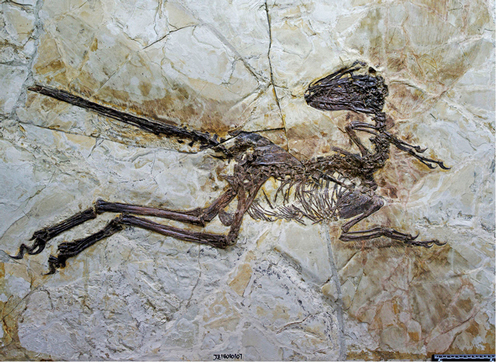How do we Know that Zhenyuanlong was Quite Big?
A few days ago, on July 16th, Everything Dinosaur team members published an article that featured the newly described Chinese dromaeosaurid dinosaur known as Zhenyuanlong suni. We explained why the dinosaur called Velociraptor was used to help give this new dinosaur discovery context and outlined some of the more intriguing aspects of the fossil, that perhaps had been missed by more general media outlets. However, we did receive an email about our article from a young dinosaur fan so we thought it best if we followed up our original article by providing some additional information about this little feathered carnivore.
To read our article (July 16th) on Z. suni: The Winged Dragon from Liaoning Province.
A Newly Described Dromaeosaurid from China
Picture credit: Zhao Chuang
Young Alex, wrote into Everything Dinosaur to ask, how do scientists know how big this dinosaur was and how big was it compared to other feathered dinosaurs found in China? We wrote to Alex explaining in a little more detail about what the scientists who studied the fossil material concluded.
The academic paper describing this new type of “raptor” was published in the journal “Scientific Reports”. The authors were Professor Junchang Lü (Institute of Geology, Chinese Academy of Geological Sciences, Beijing) and Dr Stephen Brusatte (School of GeoSciences, University of Edinburgh).
Early Cretaceous North-eastern China
Around 125 million years ago, the area of north-eastern China, now known as Liaoning Province was covered in a lush, temperate forest. Large lakes featured in the environment and nearby volcanoes occasionally erupted and buried the area in fine ash, this explains the exceptional state of preservation of much of the Liaoning fossil material.
Living in the forests were a large number of different types of “raptor”, members of the Dromaeosauridae dinosaur family. So far six genera have been described but it is very likely that more feathered dinosaur discoveries will be made in the future.
The six genera of dromaeosaurids described so far (with date described):
- Sinornithosaurus (named in 1999)
- Microraptor (named in 2000)
- Graciliraptor (named in 2004)
- Tianyuraptor (named in 2010
- Changyuraptor (named in 2014)
- Zhenyuanlong (2015)
So How Does Zhenyuanlong Compare?
The fossilised remains of Zhenyuanlong are nearly complete, but the end of the tail is missing. The skeleton measures 126.6 cm long, when compared to the large dromaeosaurid Tianyuraptor it has been estimated that with the whole of the tail, this animal would have measured more than five feet (165 cm) in length. It was probably not quite fully grown when it died so it might have reached a length of around 1.8 metres.
When it comes to comparing the sizes of different types of dinosaur, it is the limb bones that palaeontologists turn to. The thigh bone (femur) for example, is often used to make comparisons between dinosaurs. To estimate how big a dinosaur was, the length and the circumference of the femur is often measured. In simple terms, the bigger and the more robust the femur, the bigger the dinosaur.
Comparing Other Dromaeosaurids to Zhenyuanlong suni
As all the Liaoning dromaeosaurid species discovered so far have at least one thigh bone as part of their fossil material, and as the size of the thigh bone strongly correlates to body size, measuring the length and overall size of the thigh bone is a useful way of comparing the sizes of different dinosaurs.
A Table Comparing the Femur Lengths and Overall Size of Liaoning Dromaeosaurids
Table credit: Everything Dinosaur
* Depends on the species and the specimens measured
** Depends on the species as there are three species of Microraptor currently known.
So based on the length of the thigh bone, scientists can see that Zhenyuanlong (Z. suni) is much bigger than most of the other dromaeosaurids known from Liaoning. It seems to be about the size of Tianyuraptor.
What Does Zhenyuanlong suni Mean?
Time to answer one other question about this new dinosaur, this time sent in by Sophie. Sophie asked what does Zhenyuanlong mean?
The Holotype Specimen of Zhenyuanlong suni
Picture credit: Chinese Academy of Geological Science
Zhenyuanlong suni means “Mr Zhenyuan Sun’s dragon”. The word “long” means dragon in Chinese (hence other dinosaur names such as Guanlong and Dilong) and the rest of the name honours Mr Zhenyuan Sun, who was able to acquire the holotype specimen for the scientists to study.
There is a spectacular modelof Zhenyuanlong in the Beasts of the Mesozoic model series: Beasts of the Mesozoic Figures and Models.








